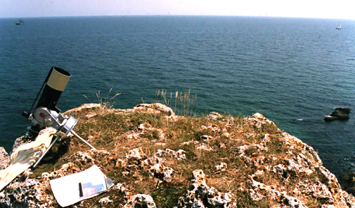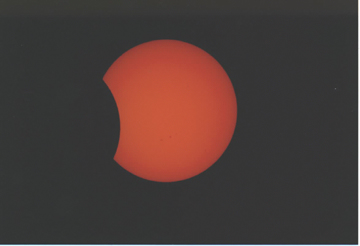Questar Distribution
![]() News
News ![]() Notes & Interesting Articles
Notes & Interesting Articles ![]() Overview
Overview ![]() Pricing
Pricing ![]() Products
Products ![]() Service or Repair
Service or Repair
Questar Telescopes ![]() LD Surveillance Systems
LD Surveillance Systems ![]() LD Microscopes
LD Microscopes ![]() Accessories
Accessories


"A TOTAL ECLIPSE OF THE SUN, OBSERVED WITH A QUESTAR TELESCOPE"
by William Chandler
The following is the text of a letter we received from a customer of Company Seven who took his Questar astronomical telescope to the Black Sea in order to observe the total solar eclipse of 11 August 1999 with the Questar Full Aperture Solar Filter. Copyright 1999; used by permission of the author with all rights reserved by the author.
"My Questar performed perfectly at the 11 August total eclipse. I have scanned a few pictures, but hesitate to send them for fear of jamming your machine. But they captured high levels of chromospheric detail -- flying flares and the like. Below, I have appended my notes from the event. I would take nothing (in exchange) for the view of totality through the Questar." bc
 Illustrated above: Bill Chandler's Questar Duplex telescope set up to photograph the eclipse. Shown with optional Counterweight System, Camera, and Camera Adapter |
A Total Eclipse of the Sun
I took a day of vacation on Wednesday, 11 August, to travel to the Black Sea coast north of Varna, to the rocky cliffs of Kamen Brjag, where a total eclipse of the Sun could be viewed. A small group of colleagues associated with EnEffect and I gathered one hour before "first contact", the start of the partial phases, to set up a Questar 1400 mm telescope, two video cameras, a digital camera, and a few point-and-shoot cameras. Viewing conditions were good. The sky was cloudless but with a high white haze and some dust and smoke from crop burning on the horizon. The air temperature was unusually high for this part of the world, and the humidity high. Our group made photographic records of the partial phases with filters, the solar corona during totality without filters, and the sky and horizon also during totality. We measured the change in temperature, watched for changes in animal behavior, noted our perception of the light and colors in the sky, and could not help but notice the crowd. We wrote down some of these observations. (See chronology below.)
I came away with three strong impressions. The first was stunning darkness, approaching from the north, blacker than any storm. Nothing in my reading had prepared me for the deep black, inverted cone approaching from the north. The sky had dimmed noticeably during the 75 minutes or so of the penumbral shadow during partial phase, but the moon's umbra quickly transformed the sky from late afternoon to evening in a matter of seconds...at just after two in the afternoon.
 Illustrated above: One of Bill Chandler's photographs of the eclipse: partial phase |
 Illustrated above: One of Bill Chandler's photographs of the eclipse: totality |
The corona itself was less spectacular. It reached only one-quarter to one-half solar radii and appeared mainly round, or smudged. I did not see it but others in my group reported seeing only one star, which they assumed to be Venus and which they saw where the planet should have been, and more than one person reported the horizon over the sea was pink and red.
As for animal behavior, sparrows quit flying first, choosing to roost in shrubs below us on the cliffs that extended down to a rocky, coral sea coast. The swallows went to roost just as totality began.
I was also struck by the bizarre behavior of some of the humans assembled to watch this rare event. Many barked like dogs or yipped like Indians at the beginning of the eclipse. Some people swam naked. One person lifted off in a noisy ultra-lite just at the beginning of totality.
Eclipse Observations, 11 August 1999
Kamen Brjak, Bulgaria
- Local
Time and Comment
12:46 First contact (eclipse begins)
13:30 Sky had noticeably darkened
13:35 Horizon more gray
13:45 Noticeable darkening relative to 13:30
14:10 North sky suddenly looms menacingly dark, the most surprising and disturbing observation of the entire eclipse. Captured by video camera.
14:11 Second contact (totality begins) Sky darkens as if a light had been extinguished
14:11 Diamond ring effect appears on the sun at an angle of two o'clock (northwest), naked eye-view; explosive quality to appearance and disappearance.
14:12 Group reports dull red and dull pink on the eastern horizon at totality. There was little color.
14:12 Corona appears round and relatively small, extending one-quarter to one-half solar diameter. Digital photographs, however, showed the diameter of the corona to extend one full solar width.
14:12 Excellent view of prominences through telescope. Chromosphere seemed in motion in a narrow band (about 1000 km deep?) between the black disk of the moon and the bright corona. A long jet appeared to form above the photosphere at an angle of about 7 o-clock on sun. It appeared above the surface and seemed to extend into the corona. Many flames rose from the surface, one at an angle of 3:30-4:00 on sun, quite large, curving back to surface.
14:13 Third contact (totality ends)
15:34 Fourth contact (partial phase ends)
Temperature Readings (simple commercial digital alarm clock thermometer)
-
Time and Reading
13:00 31.5 Degrees C. in shade
13:33 30.5 Degrees C. in shade (37 Degrees C. in sun)
13:50 29 Degrees C. in shade
13:55 28 Degrees C. in shade
14:00 27 Degrees C. in shade
~14:05 26.5 Degrees C. in shade
14:55 31.0 Degrees C. in shade
14:58 31.5 Degrees C. in shade (return to pre-eclipse level; end of temperature recording)
Maximum differential about 5.0 Degrees C.
Animal Behavior
-
There were only swallows and sparrows to be seen. The swallows were quite
active one hour before the eclipse. The sparrows went to roost first, in
groups. The swallows no longer flew (except for one) at the time of total
eclipse. Most birds had gone to roost by 14:00, according to my notes. This
behavior was confirmed by persons in my group and by an Irish amateur astronomer
who had viewed the eclipse one-half kilometer inland with an astronomy group
from his country. He reported that birds had before totality flown to roost in
trees behind the farmhouse yard where he was set-up. Birds had returned by
14:20, only 8 minutes after totality. The Irish amateur reported chickens
crowing at about that time.
The crowd was festival-like, playing radios, swimming, some naked. I have a poor idea of many people traveled to this spot but it was certainly more than a few thousand and perhaps more than 10,000.
-
Bulgarian Prime Minister Kostov arrived in a large military ship immediately
off-shore below us at this center-line of totality.
I personally saw no stars or planets but three other persons in my group and two others (including the Irish amateur astronomer) confirmed sighting the planet Venus to the lower left of the sun. p> No shadow bands were observed, despite use of Hotel Praga bed sheet as background.
Perfect crescent shadows were observed, improvised with a sheet of Fred Espenak's eclipse report riddled with holes formed with a Pentel fine point pen and held one meter above a Hotel Praga bed sheet laid horizontally on the ground."
-
Prominences: Questar 3.5" with Olympus OM-1 close-coupled (1400 mm focal length)
working at f/16 (t/22), with 1/250 second exposure on Kodak Gold 400 ISO
developed for 100 ISO. North is up and east is right.
Diamond Ring: Same as above, but with 1/500 second exposure.
-
1. William Chandler only recently became an active amateur, after dabbling for
some decades. He is an energy and environmental scientist with the Battelle
Memorial Institute.
2. Fred Espenak and Jay Anderson, Total Solar Eclipse of 1999 August 11, NASA Center for AeroSpace Information, 1998, obtained from the Internet; Rainer Beck, Heinz Hilbrecht, Klaus Reinsch, and Peter Vűlker, Solar Astronomy Handbook (Richmond, Virginia: Willmann-Bell, Inc., 1995), purchased from Sky Publishing; Edwin L. Aguirre, "Imaging Totality," Sky & Telescope, July 1999, Vol. 98, No. 1, pp. 136-141; B. Ralph Chou, "Solar Filter Safety," Sky & Telescope, February 1998, Vol. 95, No. 2, pp. 36-40.
3. This article was published in "Star Dust", the Newsletter of the National Capital Astronomers in thier October 1999 edition.
4. Copyright 1999; used by permission of the author with all rights reserved by the author.
Contents Copyright 1994-2000 Company Seven - All Rights Reserved

